Don’t let an inferior soldering station melt your patience. These top models rule for any home electronics repair.
BobVila.com and its partners may earn a commission if you purchase a product through one of our links.

Photo: depositphotos.com
Most DIYers familiar with nails, glue, paintbrushes, and spackle knives, are fairly confident about tackling home repairs. Yet fixing electronics—such as a television, computer board, or even a drone—can be intimidating. The tiny parts, intricate wiring, and expensive components can seem DIY-prohibitive. While these concerns have some validity, successful home electronics repair is possible—as long as you have a reliable soldering solution.
A soldering station is an electronics repair tool that allows the user to adhere computer chips, wires, resistors, and transistors together. They’re small enough to sit on a desktop and powerful enough to melt away thick layers of solder. The benefit of using the best soldering station over a standard iron is that you can set the temperature of the tip precisely to suit your needs. There are several different styles of soldering stations, however, so it is important to understand which is best for your projects and which ones are truly top-notch.
- BEST OVERALL: Hakko FX888D-23BY Digital Soldering Station
- RUNNER UP: YIHUA 862BD+SMD ESD Safe 2 in 1 Soldering Station
- UPGRADE PICK: YIHUA 853D 2A Hot Air Rework Station
- BEST CONTACT: X-Tronic 3060-PRO-ST-ACC – 75W Soldering Iron Station
- BEST LEAD-FREE: Yihua 939D+ Professional Digital Soldering Station
- BEST HOT AIR: TXINLEI 8586 110V Hot Air Rework Station
- BEST BANG FOR THE BUCK: Weller WLC100 40-Watt Soldering Station
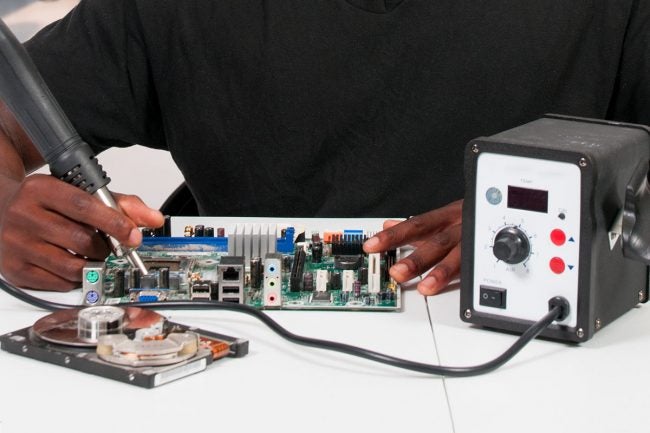
Photo: depositphotos.com
Types of Soldering Stations
All soldering stations have a similar look, but they vary slightly in the way they work. You may wish to go very basic with a contact kit or take on high-end, pro-level projects with an infrared station.
Contact Soldering Stations
Contact soldering stations use one of the most commonly recognized form of soldering: a gun or a pen hooked up to an electrical source to heat a stick or spool of leaded soldering wire. The solder then runs onto the wires or circuit and cools, making one connection out of several pieces.
Contact soldering stations have adjustable temperature settings, allowing you to solder a wider range of electronics and boards without overheating and damaging them. They come in a range of wattages, which determines how well the machine can maintain its temperature while in contact with a joint. Large joints can pull all the heat out of a lower wattage machine, while higher wattages will remain at optimal temperatures longer.
Lead-Free Soldering Stations
Lead’s harmful effects on health, including anemia, weakness, as well as kidney and brain damage, have prompted a move in the electronic community to create lead-free solders. These use a mixture of conductive metals—tin, silver, and copper—to melt onto a joint and create a solid connection. Lead-free soldering stations differ from their standard contact counterparts in that lead-free solder requires higher temperatures. Standard leaded machines may not reach a high enough melting temperature for lead-free solder or, if they do, the tips will often burn out quickly.
Hot Air Soldering Stations
Hot air soldering stations, also called rework stations, use a gun to wash hot air over electronic components to create a soldered bond. First, soldering paste is placed on the joint and then the two components are connected. Then, the user waves the hot air gun, set to a correct temperature, over the components to heat the paste, which then becomes shiny and pulls the parts into place.
Hot air stations allow DIY-electronics technicians to rework a board by removing components. The user simply washes over the joint with the gun (set at the proper temperature) until the solder heats enough to separate the components. This helps users save parts and replace components on functional boards.
Infrared Soldering Stations
Infrared soldering stations work similarly to hot air soldering stations in that the user places a soldering mixture between the joint and then heats the joint to create a connection. The difference is that an infrared station uses a laser to heat the joint—a faster method, both in set up and in heating.
The user can heat the component instead of the joint by pointing the laser directly onto the component. There’s also less chance of inaccurate soldering since the laser doesn’t blow components around as a hot air soldering station might.
Infrared stations tend to be more expensive and less accessible to DIYers. They’re more suitable for professional shops that need to work quickly to maintain their bottom line.
What to Consider When Buying a Soldering Station
Keep the important factors below in mind when shopping for the best soldering station for your needs.
Digital vs. Analog
Some circuit boards require lower temperatures than others, and if you have a go at them with a standard do-all soldering iron, you stand a good chance of destroying them. Analog temperature settings use a dial that you turn manually to the desired temperature—and they sometimes miss the mark. To gauge accuracy, you must measure the temperature with a temperature gun at the tip, and adjust accordingly.
Digital temperature settings, generally pricier than analog, can calibrate for easier use. Simply adjust the temperature with the machine and check the temperature at the tip. If the numbers don’t match, you can calibrate the machine to read correctly. This is a far more convenient way to ensure the correct temperature time after time.
Wattage Rating
Most DIY soldering irons (non-station) have wattage ratings between 15 and 25 watts, while some stations can be as high as 75 watts. This rating determines how long a soldering iron will take to heat up and how well it will maintain its heat in a given situation. If you’re soldering a heavy joint with a 15-watt soldering iron, the tip may cool too much to move onto another joint right away. Solder with a 75-watt model and you would be able to move from joint to joint much quicker.
This recovery rate is directly related to the wattages, so DIYers looking to solder an entire circuit board will find higher wattages to be the most useful. For those creating wiring looms for vehicles or trailers, a lower wattage or standard iron would work.
Variable Temperature
DIY electronics technicians will benefit from a soldering station’s adjustable temperature settings. While the temperature at the tip of the iron isn’t necessarily the only consideration, users should use the lowest possible temperature as is effective.
The reasons for lower temperatures are many. Among the most important, cranking a soldering iron up to as hot as it can go will surely burn out the tip, creating an oxidized and misshapen tip that will lose its effectiveness. And some components handle heat better than others. If you exceed a component’s temperature, you stand the risk of damaging it, and you might not know it until you get your device all buttoned up.
Replaceable Tip
If you purchase a contact-style soldering station, the iron must have replaceable tips. Some tips work better in certain scenarios. For example, a chisel tip may be best suited for heating large joints and removing parts. At the same time, a fine point is more suitable for heating tiny joints without affecting the other joints around it.
Many soldering stations are sold in kits that include a variety of tips. You can also buy replacements (available here on Amazon), so you needn’t go to the manufacturer to replace a tip that’s no longer usable. They do burn up after a while, so it’s important to purchase a quality station that allows you to swap them out.
Accessories
Electronic work can be an exciting hobby. As with most hobbies, there’s a wide range of gear that you can purchase to make it more enjoyable. These include a hands-free holder that holds a workpiece in place while you heat or melt the solder and a tip cleaner that removes flux from the end of your soldering iron, keeping your joints cleaner for minimal resistance. Also, if your soldering station doesn’t come with a set of tools for placing small components onto an electronic board, you can buy a full set separately (available here on Amazon).
Tips for Buying and Using a Soldering Station
When it comes to soldered joints, oxidation—a form of corrosion between the soldering iron’s tip and oxygen, accelerated by heat—is the enemy. To help combat oxidation, soldering pros use flux: a chemical cleaning agent that helps prevent oxidation and promotes the flow of solder, allowing the solder to attach itself more easily to the joint. The best option is to use hollow soldering wire with a rosin core; rosin is a flux chemical that helps the solder flow and reduces the effects of oxidation.
Soldering creates fumes and smoke. While most smaller jobs aren’t an actual health hazard, the fumes can give you a sore throat and possibly a headache, so it’s wise to always ventilate the areas where you’re soldering: Open a window and use a fan to extract the irritants from the room, and consider wearing an N95 mask if you’re particularly sensitive.
If you’re soldering a wire onto a control board, one pro move is to pre-tin the tip of the wire. Pre-tinning is the action of melting a bit of solder onto the wire end first before soldering it to the board. This ensures that the tip of the wire is oxidation-free, and it allows the solder to attach faster to finish with a far more reliable result.
- Use a rosin-core solder to help minimize oxidation.
- Keep the area well-ventilated or wear a mask to avoid fumes.
- Pre-tin wire ends before soldering to a control board for the best results.
Our Top Picks
Now that you’re up on soldering station styles, important shopping factors, and helpful tips to solder like a pro, you’re ready to purchase the best soldering station for your needs. The following eight were chosen with all the key considerations in mind.
Best Overall
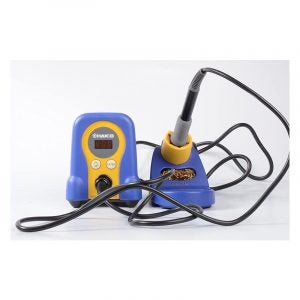
For a soldering station to rank as best overall, it must offer a wide range of temperatures, plenty of wattage, and be a good value. The Hakko FX888D-23BY ticks all of those boxes. This 70-watt contact-style soldering station features a digital display that allows you to dial in the perfect temperature (between 120 and 899 degrees Fahrenheit), and the tips are replaceable, so you’ll be able to continue using this tool for years to come. There’s also a tip cleaning station to help you maintain the best possible soldered joints, free of excessive oxidation and flux.
Runner Up
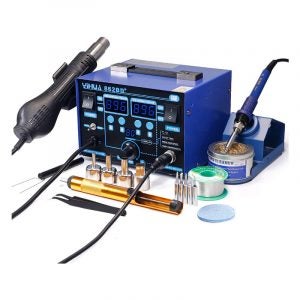
If you’re thinking of getting into a rework project, arm yourself with a top-notch hot air rework station. The 862BD+ from YIHUA is the ideal setup for home DIY electronic repair benches, as it offers a digital temperature display, a hot air gun, and a soldering iron. It also comes with swappable tips for both the air gun and the soldering iron, so you can choose exactly the right tip for the job at hand. The 75-watt soldering iron reaches temperatures between 392 and 896 degrees Fahrenheit, while the air gun has a range of 212 to 896 degrees Fahrenheit. It also features a tip cleaning station and a safety shut-off that immediately shuts the air gun down when it’s in the holder.
Upgrade Pick
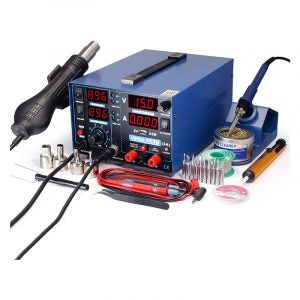
The YIHUA 853D 2A is a hot air rework and soldering station with some automatic features that make it worth the upgrade price. There are four digital gauges, showing the hot air gun’s temperature, the soldering iron’s temperature, the voltage you’re using, and the amps the machine is drawing. This allows the user to fine-tune their settings for excellent results. The machine’s 75-watt soldering iron heats to temperatures between 392 and 896 degrees Fahrenheit, while the hot air gun will create temperatures between 212 and 896 degrees. The 853D 2A features automatic temperature readings and will adjust accordingly, allowing the user to move quickly between joints without losing time. It also has safety shut-offs that will automatically shut the machine down if the fan stops running during use. It comes with swappable tips for both the iron and the fan as well.
Best Contact
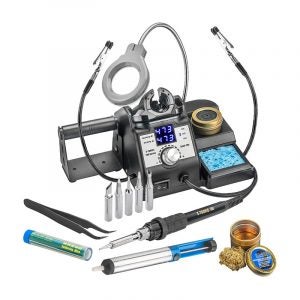
The XTronic 3060-PRO-ST-ACC contact soldering station has plenty of power and convenient features to make your soldering projects quicker, easier, and more enjoyable. This 75-watt soldering station’s iron reaches temperatures between 392 and 896 degrees Fahrenheit, while also heating up within 30 seconds. Temperatures are easy to read with the 3060-PRO-ST-ACC’s digital display. It also features two “helping-hands” to hold your workpiece in place while you feed solder and manipulate the iron with your hands. There’s a holder for a tip cleaner (the tip cleaner is sold separately here), as well as a space for a wet sponge, ensuring that you get the best quality joint.
Best Lead-Free
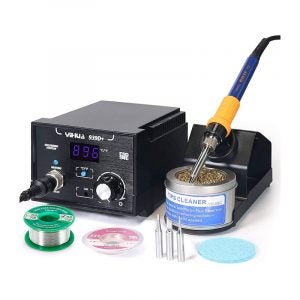
For DIYers that prefer to use lead-free solder, the Yihua 939D+ soldering station is a solid choice. This digital contact soldering station’s iron reaches temperatures between 392 and 896 degrees Fahrenheit, so it’s certainly hot enough to liquefy lead-free solder. In fact, Yihua is so confident with this machine’s lead-free capabilities that it includes a roll of lead-free solder in the kit. It also features three replaceable tips, allowing you to choose the right one for the job, and also replace the tips once they’re past their usable state. It comes with a soldering tip cleaner—important for the best possible lead-free joints. Note: While Yihua claims that this soldering iron is equivalent to a 75-watt iron, the company is not explicitly clear on the actual wattage.
Best Hot Air
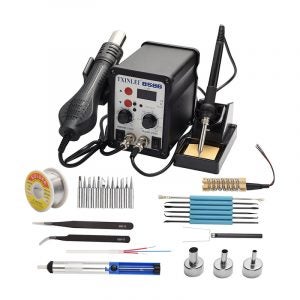
If you’re new to rework, the TXINLEI 8586 Hot Air Rework Station comes with everything you need to get started. This kit includes a hot air gun, a soldering iron, swappable tips, tweezers, a desoldering pump, brushes, picks, and soldering wire. The digital display allows the user to dial in the exact temperature for the type of work, and the 60-watt soldering iron is powerful enough for most jobs, reaching the same temperatures as most other kits with a slightly slower recovery time. The hot air gun reaches temperatures between 392 and 840 degrees Fahrenheit. The 8586 also boasts a built-in tray for wet sponges, making cleaning the iron’s tip quick and easy.
Best Bang for the Buck
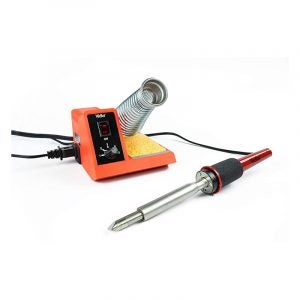
The value-priced Weller WLC100 doesn’t fall short in terms of capability. Its 40 watts of power are enough for most DIY projects that don’t require soldering an entire control board. It has a built-in tray for a wet sponge so you’ll be able to keep the iron clean. While the temperature adjustment is analog, Weller’s reputation ensures that it’s accurate and that you’ll have top-quality results. The wrapped-wire iron holder will keep your work surface safe from the iron’s hot tip and the WLC100 has replaceable elements and tips—which most lower-end soldering stations don’t—making this a standout tool in the budget price range.
tinyurlis.gdv.gdv.htu.nuclck.ruulvis.netshrtco.detny.im
مقالات مشابه
- شرکت صادرات و واردات کالاهای مختلف از جمله کاشی و سرامیک و ارائه دهنده خدمات ترانزیت و بارگیری دریایی و ریلی و ترخیص کالا برای کشورهای مختلف از جمله روسیه و کشورهای حوزه cis و سایر نقاط جهان - بازرگانی علی قانعی
- ظروف مسی خرید آنلاین انواع ظروف مسی نانو شده با تخفیفات ویژه
- آموزش تعمیرات موبایل [جزوه رایگان + 100% تضمینی]
- چیزهایی که دوست ندارید در مورد لباس بچگانه و چیزهایی که دوست خواهید داشت
- خانه بیل Earmarks $1M به تغییر نام پایگاه ارتش تجلیل مؤتلفه رهبران
- فعال ترین وظیفه سربازان شديد COVID-19 باید موجود شرایط سلامت, مطالعه می یابد
- The Best Sleeping Bags for Camping and Travel
- Underused راحتی به ترک نیویورک, آماده شدن برای یکی دیگر از بیماری همه گیر ماموریت در صورت نیاز
- کامالا هریس سرمایه گذاری های خصوصی جدیدی را با هدف کاهش سرعت مهاجرت از آمریکای مرکزی اعلام می کند
- شرکت صادرات و واردات کالاهای مختلف از جمله کاشی و سرامیک و ارائه دهنده خدمات ترانزیت و بارگیری دریایی و ریلی و ترخیص کالا برای کشورهای مختلف از جمله روسیه و کشورهای حوزه cis و سایر نقاط جهان - بازرگانی علی قانعی